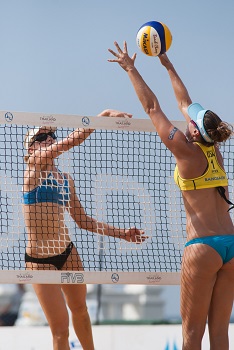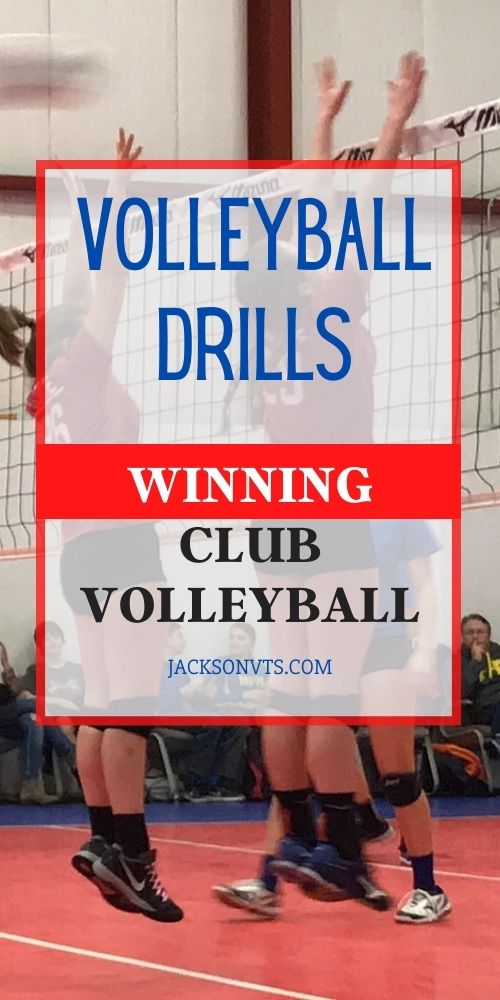Volleyball strategy for beginning volleyball teams and winning in youth volleyball.
What to Teach Beginning Players
Teaching beginning players can often seem like an impossible task. Beginning players often can’t even serve the ball over the net.
Blocking Volleyball Strategy
Also, a lot of times the team will get stuck in serve receive and not be able to pass at all.
This can be a frustrating experience for both the coach and the players.

Importance of Fundamentals
It often becomes obvious how important skills training is. For example, if you can’t serve the ball over the net, it’s obvious to work on serving. If your opponent serves 15 straight points because your team can’t pass the serve, it’s obvious to work on passing.
What to work on in youth volleyball is much more obvious than when playing at higher levels.
Beginning players lack skills, and it’s more obvious how important skills training is in youth volleyball.
At higher levels of volleyball, players have better skills and can rely on focusing on volleyball strategy more. At higher levels, players can just focus on playing more and getting more experience. Poor skills don’t stand out so much.
The following are important skills for beginning players.
- Overhand serving. You want to learn to serve overhand as soon as possible. There really isn’t any benefit to learning to serve underhand. The overhand serving motion is similar to the overhead motion for spiking. The more you practice serving overhand, the more you’ll improve at the overhand spiking motion.
- Ball contact for spiking. When first learning to play, it’s very important to learn how to contact the ball for spiking. The most important part of the volleyball approach is the ball contact. Even if you aren’t comfortable approaching to spike and you would prefer to spike from standing on the ground, focus on the ball contact.
The ball should be contacted in a way that creates topspin on the ball. The ball should always spin after making contact. Focus on the pre-contact hand position (claw) and create topspin with every hit. - Forearm passing. The worst habit that most common for youth players is passing by “swinging the arms”. Focus on not swinging. Work on moving forward to the ball and also moving with the ball (moving backwards). The forward/backward movement in volleyball is the most common movement that needs to be practiced.
- Setting. Have all the players learn to hand set. Setting isn’t just for setters. There will be times when every player on the team will need to hand set. Have all players develop good overhead hand sets. The object of the game is to get the hitter a good set to hit. The more players you have that can hand set, the more likely you’ll get kills and win.
Volleyball Strategy for winning in youth volleyball
The following are basic volleyball strategy for beginning teams…
- Serving deep. Most youth volleyball teams (players younger than 15) have trouble passing the deep serve. And even when the deep serve gets passed, most teams can’t pass the ball up to the net to the setter. Deep serves are a great volleyball strategy because serving deep will keep a team from running their offense. Most often deep serves result in a point or at the very least a free ball.
Short serves are easier to pass and the team will more likely set an attacker off a short serve. It’s also easier to pass this ball to the setter because the ball doesn’t have to travel as far.
What’s best movement strategy for passing? Forward? Backward? Side to side?
- W formation. The W formation is the most common formation used by beginning teams. The W allows teams to cover more court and intercept the path of the ball that’s most likely to occur. The goal in the beginning should be all about long rallies and ball control. Teams need to focus on communication, playing hard, and rally, rally, rally.
- Spiking off the net. In the beginning, have the team focus on keeping the passes off the net and the sets off the net. It’s not about getting kills, it’s about the spiker getting in position to spike and volleyball hitting with topspin. Focus on ball control. Rally, rally, rally should be the focus.
- Learn rotation. Players need to understand the volleyball lineup. Players need to learn what their role on the team. Understand your job will help you understand volleyball strategy. Players should know who they are opposite and between. The better you understand the rotation, the easier it will be to make plays. Communicating with teammates, understanding your role, and anticipating what to do are all very important when it comes to being successful in youth volleyball.
If you enjoyed these tips and would like to keep it close to you at any time, just save this pin to your Pinterest Volleyball Training Board.

Home › How to Play › Strategies
